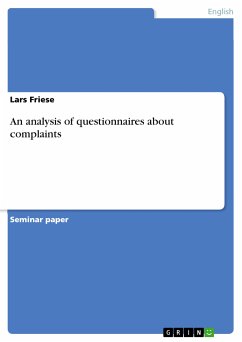Seminar paper from the year 2004 in the subject English Language and Literature Studies - Linguistics, grade: 1,7 (A), University of Münster (Englisches Seminar), course: Linguistik Hauptseminar Cross-cultural Pragmatics, language: English, abstract: What would you say if your best friend destroys your camera he has borrowed from you? And how do you react if you wait a long time for your meal in a restaurant, and when it is finally served, it is cold? How would another person react? This paper tries to investigate and analyze complaints in such everyday situations. Therefore, our group in the seminar Cross-Cultural Pragmatics (summer semester 2002) at the English department of the University of Münster constructed a discourse completion test about complaints and distributed it to several volunteers. Based on current linguistic theory, I will now evaluate the data with respect to self-formulated hypotheses. First, I will deal with theoretical background information on complaints which is mostly based on Olshtain’s and Weinbach’s research (Olshtain and Weinbach 1993). This chapter introduces a linguistic definition of “complaints” and some basic facts about the concept of ‘face’ and so-called face-threatening acts. In addition to this, preconditions for complaints, “payoff” considerations and different categories of complaints will be presented and analyzed. Then, in chapter 3, I will put forward 3 working hypotheses which will establish the focus of the following analysis. Furthermore, in chapter 4, the construction of our questionnaire is explained in detail as well as different social variables that are essential for the study. In the main part, chapter 5, the collected data are presented and analyzed. Moreover, not only difficulties in evaluating the data are reflected here, but also an evaluation of my 3 hypotheses. The conclusion in chapter 6 summarizes the findings and presents perspectives as well as limitations of the study. Chapter 7 is the bibliography, and the appendix (chapter 8) contains both the English and the German version of the questionnaire and tables of the data which is the basis for my diagrams.








